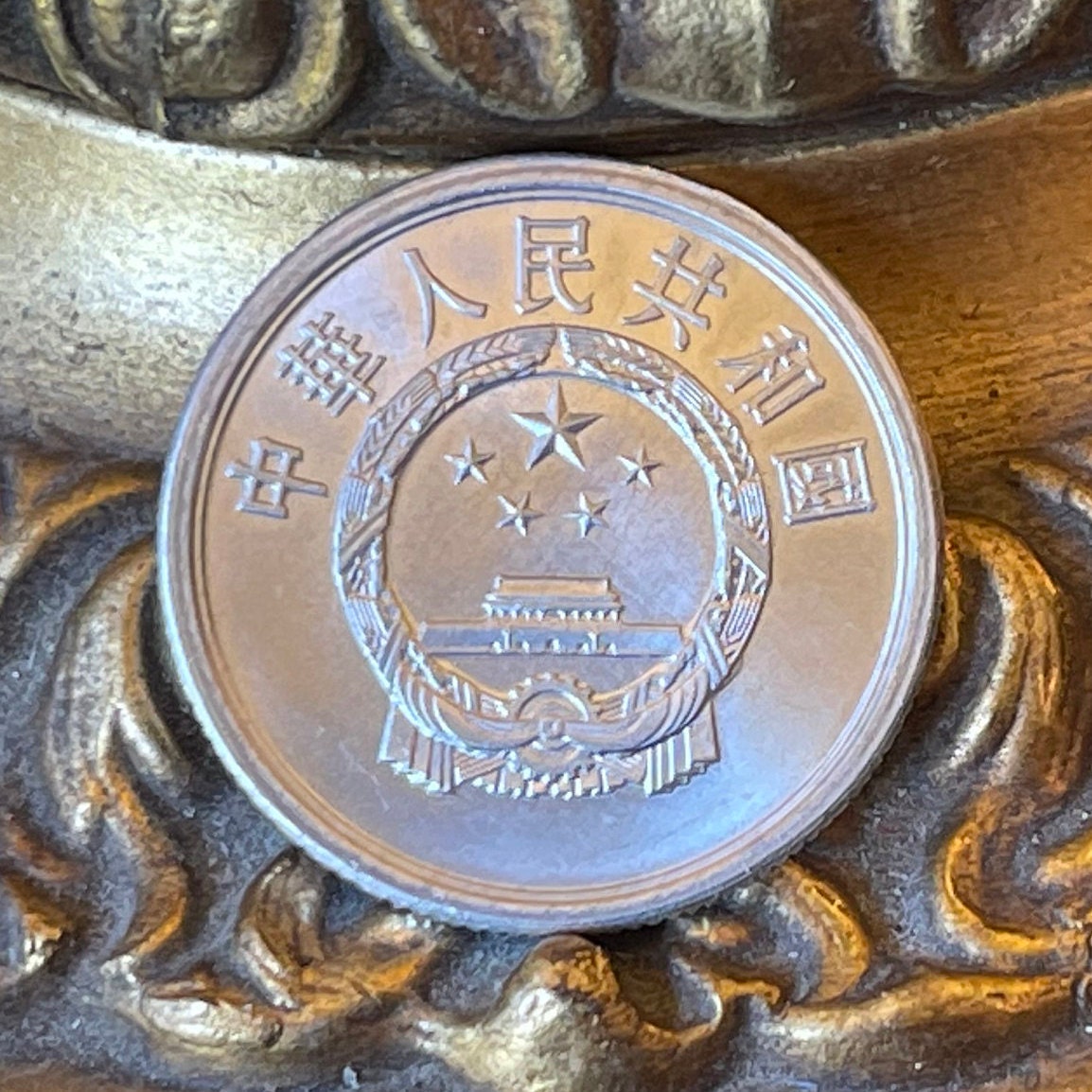elemintalshop
Tiananmen Gate 5 Fen China Authentic Coin Money for Jewelry and Craft Making (Gate of Heavenly Peace)
Tiananmen Gate 5 Fen China Authentic Coin Money for Jewelry and Craft Making (Gate of Heavenly Peace)
Couldn't load pickup availability
Tiananmen Gate 5 Fen China Authentic Coin Money for Jewelry and Craft Making
Obverse: China's emblem: Tian'anmen, "Gate of Heavenly Peace", gate to the forbidden city, 5 stars above it.
Lettering: 中 華 人 民 共 和 國
Translation: People's Republic of China
Reverse: Ears surrounding the face value
Lettering:
5
伍分
1990
Translation:
5
Five Fen
1990
Features
Issuer People's Republic of China
Period People's Republic (1949-date)
Type Standard circulation coin
Years 1955-2000
Value 5 Fen
0.05 CNY = USD 0.0075
Currency Second Rénmínbì (1955-date)
Composition Aluminium
Weight 1.6 g
Diameter 24 mm
Thickness 1.8 mm
Shape Round
Technique Milled
Orientation Medal alignment ↑↑
Number N# 1219
References KM# 3, Y# 3
Wikipedia:
The Tiananmen (also Tian'anmen, Tienanmen, T’ien-an Men) ([tʰjɛ́n.án.mə̌n]), or the The Gate of Heavenly Peace, is a monumental gate in the city center of Beijing, China, the front gate of the Imperial City of Beijing, located near the city's Central Business District, and widely used as a national symbol. First built during the Ming dynasty in 1420, Tiananmen was the entrance to the Imperial City, within which the Forbidden City was located. Tiananmen is located to the north of Tiananmen Square, and is separated from the plaza by Chang'an Avenue.
The building is 66 meters (217 ft) long, 37 meters (121 ft) wide and 32 meters (105 ft) high. Like other official buildings of the empire, the gate itself has unique imperial roof decorations.
Two lions stand in front of the gate, and two more guard the bridges. In Chinese culture, lions are believed to protect humans from evil spirits.
Two stone columns, called huabiao, each with an animal (hou) on top of it, also stand in front of the gate. Originally, these installations were designed for commoners to address their grievances by either writing or sticking petitions on the columns. However, the examples in front of the Imperial City were purely decorative, and instead connoted the majesty of the imperial government.
The western and eastern walls have giant placards; the left one reads "Long Live the People's Republic of China" (中华人民共和国万岁; Zhōnghuá Rénmín Gònghéguó wànsuì), while the right one reads "Long Live the Great Unity of the World's Peoples". The right placard used to read "Long Live the Central People's Government" (中央人民政府万岁; Zhōngyāng Rénmín Zhèngfǔ wànsuì) for the founding ceremony of the PRC, but after the ceremony it was changed to "Long Live the Great Unity of the World's Peoples" (世界人民大团结万岁; Shìjiè rénmín dà tuánjié wànsuì). Both placards were changed to use simplified Chinese instead of traditional Chinese characters in 1964. The phrasing has significant symbolic meaning, as the phrase used for long live, like the Imperial City itself, was traditionally reserved for Emperors of China, but is now available to the common people.
The reviewing stands in the foreground are used on International Workers Day (May Day) and on the National Day (October 1) of the People's Republic of China.
In front of the stands is the Imperial City's moat, still filled with water but now containing decorative illuminated fountains.
In ancient times, the Tiananmen was among the most important gates encountered when entering Beijing's Imperial City along with the Yongdingmen, Qianmen, the Gate of China. Proceeding further inward, the next gate is the 'Upright Gate', identical in design to the Tian'anmen; behind it is the southern entrance of the Forbidden City itself, known as the Meridian Gate.
Due to its historical significance, Tiananmen is featured on the National Emblem of the People's Republic of China. It has also been featured in the designs of stamps and coins issued by the People's Republic of China.
Share



















